Have you ever wondered how we keep satellites perfectly positioned in space? The secret lies in an extraordinary concept known as the Lagrangian Point. These unique spots in space are pivotal in the world of astronomy and space exploration. Let’s dive into the mysteries of Lagrangian Points and discover why they are so important.
Science Behind It: Why Do We Float In The Dead Sea?
What Are Lagrange Points?
 Image: NASA
Image: NASA
Lagrange points are special spots in space where the gravitational forces of a two-body system, such as the Earth and the Sun, create areas of increased stability.
These points effectively balance the centripetal force experienced by a smaller object, allowing it to remain stationary relative to the two larger bodies.
Named after the French-Italian mathematician Joseph-Louis Lagrange, who first proposed them in 1772, there are five Lagrange points, designated as L1 through L5, each with its own distinct characteristics.
Why Are There Stones On Railway Tracks?
The Five Lagrange Points in Detail
There are five Lagrange Points, labelled L1 to L5, each with unique properties and distances from Earth.
L1 (First Lagrange Point)
Location: Between the Earth and the Sun.
Distance from Earth: Approximately 1.5 million kilometres (0.01 AU).
Applications: The Lagrange Point L1 is an advantageous location for solar observation missions. One key example is the positioning of the Deep Space Climate Observatory (DSCOVR) at this point, enabling it to provide real-time solar wind data and issue early warnings about geomagnetic storms that could impact Earth.
L2 (Second Lagrange Point)
Location: On the opposite side of Earth from the Sun.
Distance from Earth: Approximately 1.5 million kilometres (0.01 AU).
Applications: The Lagrange Point L2 is particularly well-suited for space telescopes like the James Webb Space Telescope (JWST). Its location provides a stable environment for conducting deep-space observations, with minimal thermal interference from Earth. This unique positioning allows telescopes to maintain a cold temperature, enabling them to capture detailed images of faint celestial objects.
L3 (Third Lagrange Point)
Location: Directly opposite the Earth on the far side of the Sun.
Distance from Earth: Approximately 150 million kilometres (1 AU).
Applications: The Lagrange Point L3 is rarely used due to communication challenges and its position behind the Sun, which obstructs direct communication with Earth. However, it could theoretically be useful for observing solar phenomena that are not visible from Earth.
L4 (Fourth Lagrange Point)
Location: Leading Earth in its orbit around the Sun by 60 degrees.
Distance from Earth: Approximately 150 million kilometres (1 AU) from the Sun.
Applications: The Lagrange Point L4 is a gravitational balancing point in space where objects can remain relatively stable. This point has the potential to be an ideal location for future space colonies due to its stability, and it also offers a unique environment for studying gravitational effects. Additionally, L4 is known for hosting groups of asteroids called Trojan asteroids.
L5 (Fifth Lagrange Point)
Location: Trailing Earth in its orbit around the Sun by 60 degrees.
Distance from Earth: Approximately 150 million kilometres (1 AU) from the Sun.
Applications: The Lagrange Point L5, similar to L4, is a point in space where gravitational forces create a stable position. It is an attractive location for potential space habitats and scientific research. Additionally, L5 is home to Trojan asteroids, which offer valuable information about the formation of the early solar system.
What is Space Junk (Debris) and why is it a global threat?
The Science and Mechanics of Lagrange Points
Lagrange Points are positions in space where the gravitational forces and the orbital motion of a body create a stable equilibrium. Mathematically, these points are solutions to the restricted three-body problem, which involves the gravitational interaction among three bodies, such as a spacecraft, the Earth, and the Sun.
These points, denoted as L1, L2, L3, L4, and L5, have different characteristics. L1, L2, and L3 are points of unstable equilibrium, meaning that a small disturbance can cause the object to move away from the point.
On the other hand, L4 and L5 are points of stable equilibrium, forming equilateral triangles with larger bodies, which allows them to trap dust and asteroids, such as the Trojan asteroids.
Science Quiz On Solar Eclipse With Answers
Why Are Lagrange Points Important?
Lagrange points are essential for several reasons:
Stability: Objects positioned at L4 and L5 remain stable with minimal fuel consumption, making them ideal for long-term missions.
Continuous Observation: L1 and L2 provide unique vantage points for continuous observation of the Sun and deep space, respectively, without the interference of Earth's atmosphere.
Fuel Efficiency: Placing spacecraft at these points reduces the need for constant adjustments, conserving fuel and extending mission lifetimes.
Science Quiz On Space Debris With Answers
Real-World Space Missions At Lagrange Points
 Image: ISRO
Image: ISRO
DSCOVR at L1: Positioned approximately 1.5 million kilometres from Earth, the DSCOVR spacecraft monitors solar wind and provides early warnings about geomagnetic storms. These storms can disrupt power grids, satellites, and communications systems. The spacecraft's unique vantage point allows continuous observation of the sunlit side of Earth, making it invaluable for space weather forecasting.
James Webb Space Telescope at L2: The James Webb Space Telescope, located at L2, remains in a stable position relative to Earth and the Sun. This positioning minimizes the need for fuel adjustments and provides an ideal environment for infrared observations. Additionally, this placement ensures that the telescope's instruments remain cool, crucial for the sensitive infrared detectors.
 Image: ISRO
Image: ISRO
Aditya-L1 Mission at L1: India's Aditya-L1 mission aims to place a spacecraft at the L1 point to study the Sun. By observing solar activities and their effects on space weather, Aditya-L1 will enhance our understanding of solar dynamics and improve our ability to predict space weather events.
Conclusion
In conclusion, Lagrange Points offer unique advantages for space exploration and observation. They provide stable or semi-stable locations for various missions, enabling continuous observation of the Sun, deep-space telescopes, and potential sites for space habitats. As our understanding of these points and our technological capabilities advance, the utilization of Lagrange Points will likely expand, opening new frontiers in space exploration.
What is a Black Hole? Which Is The Biggest Black Hole In The Universe?
Comments
All Comments (0)
Join the conversation